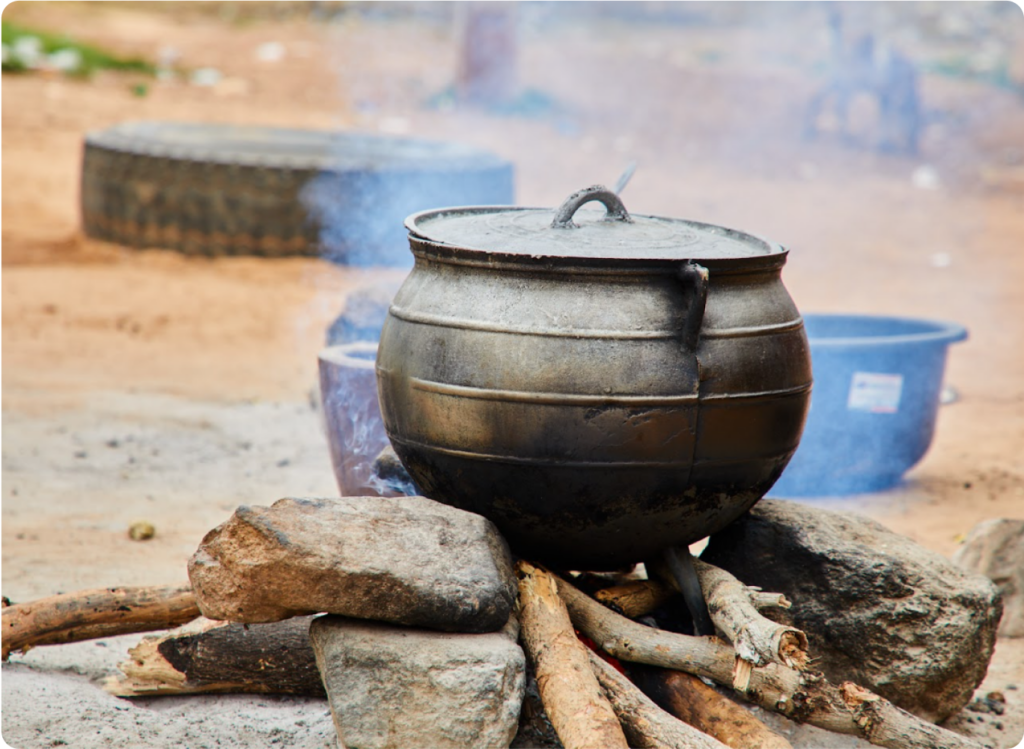Cooking
Sector Breakdown
40 MtCO2
Emitted in 2020
Emissions from the oil and gas sector are attributable to fugitives, upstream energy consumption(/fuel use), venting and flaring.
161 MIL
People in Nigeria

(74% of the population) lack access to clean cooking resulting in significant quality and length of life repercussions for mainly women and children in the country.
Decarbonization Strategy
The key decarbonization strategy is a move from traditional firewood, charcoal and kerosene to Liquefied Petroleum Gas (LPG) (until 2030), efficient wood stoves, electrification and biogas (particularly in rural areas).
LPG plays a significant role up to 2030 due to urgency of the achievement of universal access to clean cooking (SDG7), the relevance of the fuel across household categories and Nigeria’s natural gas endowment. However, LPG is a stepping-stone in Nigeria’s Net Zero strategy.


Biogas and electric cookstoves are prioritized for deployment post 2030 since they are carbon neutral:
- Electric cookstoves are used in grid-connected households
- Biogas is available in rural areas which employ off-grid sources for primary electricity supply.
Significant reduction of energy needs is also expected despite population increase as inefficient firewood stoves are replaced by more efficient technologies.
Adoption of e-stoves drives decarbonization of cooking sector
Total cooking demand (‘000 Units)

No Data Found
- lpg
- electric
- Biofuels
- traditional Biomass
Key insights
- Demand for electric grows 3-fold between 2030-2060, as universal access to electricity is being achieved
- Demand for LPG stoves peaks in 2030 and is phased out in the early 2050’s, as e-cooking becomes more available
- Demand for biofuels is limited, but constant throughout the decade, as they serve as a cheaper alternative to LPG and E-stoves.
- Traditional biomass is phased out in 2030, and is mostly prevalent in rural areas
Underlying assumptions
- Universal access to energy is achieved by 2030
- Reliable infrastructure for LPG and electricity distribution in urban and rural areas
- Policy and financial incentives to offset high premium cost of LPG and e-stoves
- Latest population projection is based on UN SSP2 scenario, which estimates a population growth by 2-fold between 2020-60.
Total cooking demand in
urban areas increase by ~65%
over the three decades
Urban Cooking demand, (‘000 units)

No Data Found
- lpg
- electric
- Biofuels
- traditional Biomass
Key insights
- Total cooking demand in urban areas grows in line with expected population growth
- By 2060, 90% of urban households are supplied by electric stoves
- A minority of the population likely leaving in peri-urban areas, is still using biofuels until 2060, likely as a cheaper alternative to LPG and e-stoves
- LPG stoves are phased out by 2040 in line with goals of NZE by 2060 but play an important role as a transition technology in the first decade
- Traditional biomass stoves are phased out in 2030, as LPG and e-stoves becomes more available.
Underlying assumptions
- 100% electricity in urban and peri-urban areas by 2030
- Reliable and stable grid in urban areas to accommodate e-cooking load demand
- Financial incentives to reduce the premium of high costs stoves, especially in the first two decades
Cooking demand in rural areas sees a limited demand due to a high urban migration rate
Rural cooking demand (‘000 units)

No Data Found
- lpg
- electric
- Biofuels
- traditional Biomass
Key insights
- From 2040 and onwards, >50% of the total rural households are using e-stoves
- LPG stoves are phased out by 2050, but plays an important role as alternative to the more expensive e-stoves in the earlier decades
- Biofuels also play an important role as affordable alternative to e-stoves and serves 40% of total rural population in 2060
Underlying assumptions
- Urbanization rate of 70% by 2050s, as estimated by UN Habitat, pointing to a high urban migration
- Reliable infrastructure to LPG distribution in rural areas
- Financial incentives to enable the affordability of high costs stoves, especially in the first two decades
barriers AND
Potential actions
BArriers
- High capital costs to e-cooking and social reluctance
- Dependence on traditional biomass in rural area
- Vulnerability of LPG price volatility
- Low consumer awareness
- Limited market for biofuels
- Lack of financial mechanisms
potiential actions
- A holistic clean cooking strategy that reviews the various solutions available that is viable for adoption and can be balanced to also provide co-benefits associated to clean cooking (e.g.: support to a better health, climate & environment, and gender & livelihood).
- Prioritize the implementation of the Electricity Sector Reform Roadmap to facilitate a switch to e-cook stoves.
- Develop national strategies and targets for the following:
- Securing supply chains of modern and cleaner fuels through an integrated resource planning approach.
- Support the development of a market for biofuels such as ethanol or biogas, via R&D of local opportunities for conversion and distribution of biowaste to energy.
- Develop regulations and frameworks to enable a carbon credit financing targeting private sector, to empower them to invest in cleaner, efficient and more affordable cooking technologies.
Total fuel consumption decrease by 20% driven by more efficient stoves in the market
Total Fuel demand (Pj)

No Data Found
- Biomass
- electricity
- lpg
Key insights
- Electricity takes the lion’s share of cooking fuel consumption, and grows 3-fold between 2030-60, as universal electrification is achieved.
- LPG peaks at 58 PJ in the mid-20’s and is phased out by 2050, as households move towards cleaner options.
- Biomass consumption is an important fuel until 2030, mainly due to rural households’ reliance on traditional biomass.
- After 2030, biomass consumption is driven by biofuels (biogas, ethanol, improved charcoal …etc), peaking at 36 PJ in 2060.
Underlying assumptions
- Enabling policy and financial incentives for energy efficient stoves.
- 100% electricity in urban and peri-urban areas by 2030.
- Reliable and stable grid in urban areas to accommodate e-cooking load demand.